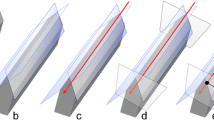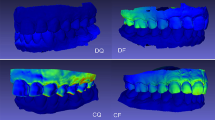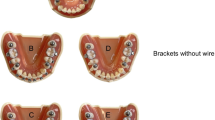Abstract
Objective
This study aimed to compare the accuracy of occlusal registration for single-unit restorations in the posterior area of the jaw using the complete-arch or quadrant scan techniques.
Materials and methods
A master cast was prepared and articulated on a nonadjustable articulator, and the maxillary left first molar was prepared for a full-coverage crown. The master cast was digitized as the reference data using a laboratory scanner (E3 scanner, 3Shape, Copenhagen, Denmark). It was scanned 10 times in the complete arch and 10 times in the quadrant, with an occlusal registration in each, using four intraoral scanners (i500, Primescan, TRIOS 3, and TRIOS 4). The scanned data were aligned to the reference data using GOM Inspect software. A three-dimensional analysis of the surface-based occlusal clearance and angular deviation, focusing on the prepared tooth, was performed.
Results
The mean surface-based occlusal clearance in the quadrant and complete-arch scans was 1.622 ± 0.032 mm and 1.642 ± 0.043 mm, respectively. Angular deviations compared to the reference cast showed a difference of 0.10° distally and 0.09° buccally for the quadrant scan and 0.12° distally and buccally for the complete-arch scan. Statistical analysis was performed using one-way analysis of variance and post hoc Scheffe’s test. No significant differences were observed between the test groups.
Conclusions
No significant differences were found between occlusal registrations of the complete-arch and quadrant scans. Therefore, a quadrant scan can achieve the same outcome as a complete-arch scan for single-unit restoration in the posterior area of the jaw.
Clinical relevance
Quadrant scanning for single-unit restoration showed similar outcomes as complete-arch scans.








Similar content being viewed by others
Data Availability
The data used in this study is available upon request from the corresponding author.
References
Yuzbasioglu E, Kurt H, Turunc R, Bilir H (2014) Comparison of digital and conventional impression techniques: evaluation of patients’ perception, treatment comfort, effectiveness and clinical outcomes. BMC Oral Health 14:10. https://doi.org/10.1186/1472-6831-14-10
Kihara H, Hatakeyama W, Komine F, Takafuji K, Takahashi T, Yokota J, Oriso K, Kondo H. Accuracy and practicality of intraoral scanner in dentistry: a literature review. J Prosthodont Res 2020;109–13. https://doi.org/10.1016/j.jpor.2019.07.010
Haddadi Y, Bahrami G, Isidor F. Accuracy of intra-oral scans compared to conventional impression in vitro. Prim Dent J 2019;34–9. https://doi.org/10.1308/205016819827601491
Tomita Y, Uechi J, Konno M, Sasamoto S, Iijima M, Mizoguchi I. Accuracy of digital models generated by conventional impression/plaster-model methods and intraoral scanning. Dent Mater J 2018;628–33. https://doi.org/10.4012/dmj.2017-208
Blatz MB, Conejo J. The current state of chairside digital dentistry and materials. Dent Clin. North. Am 2019;75-97. https://doi.org/10.1016/j.cden.2018.11.002
Malik J, Rodriguez J, Weisbloom M, Petridis H. Comparison of accuracy between a conventional and two digital intraoral impression techniques. Int J Prosthodont 2018;107–13. https://doi.org/10.11607/ijp.5643
Oh KC, Park JM, Moon HS. Effects of scanning strategy and scanner type on the accuracy of intraoral scans: a new approach for assessing the accuracy of scanned data. J Prosthodont 2020;518–23. https://doi.org/10.1111/jopr.13158
Kim MK, Kim JM, Lee YM, Lim YJ, Lee SP. The effect of scanning distance on the accuracy of intra-oral scanners used in dentistry. Clin Anat 2019;430–8. https://doi.org/10.1002/ca.23334
Nedelcu R, Olsson P, Nyström I, Rydén J, Thor A. Accuracy and precision of 3 intraoral scanners and accuracy of conventional impressions: a novel in vivo analysis method. J Dent 2018:110–8. https://doi.org/10.1016/j.jdent.2017.12.006
Keul C, Güth JF. Accuracy of full-arch digital impressions: an in vitro and in vivo comparison. Clin Oral Investig 2020;735–45. https://doi.org/10.1007/s00784-019-02965-2
Jeong ID, Lee JJ, Jeon JH, Kim JH, Kim HY, Kim WC. Accuracy of complete-arch model using an intraoral video scanner: an in vitro study. J Prosthet Dent 2016;755–9. https://doi.org/10.1016/j.prosdent.2015.11.007
Hayama H, Fueki K, Wadachi J, Wakabayashi N. Trueness and precision of digital impressions obtained using an intraoral scanner with different head size in the partially edentulous mandible. J Prosthodont Res 2018;347–52. https://doi.org/10.1016/j.jpor.2018.01.003
Favero R, Volpato A, Francesco M, Fiore AD, Guazzo R, Favero L. Accuracy of 3D digital modeling of dental arches. Dental Press J Orthod 2019;38e1–7. https://doi.org/10.1590/2177-6709.24.1.38.e1-7.onl
Ren S, Morton D, Lin WS. Accuracy of virtual interocclusal records for partially edentulous patients. J Prosthet Dent 2020;860–5. https://doi.org/10.1016/j.prosdent.2019.08.013
Atieh MA, Ritter AV, Ko CC, Duqum I. Accuracy evaluation of intraoral optical impressions: a clinical study using a reference appliance. J Prosthet Dent 2017;400–5. https://doi.org/10.1016/j.prosdent.2016.10.022
Shimizu S, Shinya A, Kuroda S, Gomi H. The accuracy of the CAD system using intraoral and extraoral scanners for designing of fixed dental prostheses. Dent Mater J 2017;402–7. https://doi.org/10.1016/j.prosdent.2016.10.022
Parker MH, Cameron SM, Hughbanks JC, Reid DE. Comparison of occlusal contacts in maximum intercuspation for two impression techniques. J Prosthet Dent 1997;255–9. https://doi.org/10.1016/s0022-3913(97)70023-4
Ender A, Zimmermann M, Mehl A (2019) Accuracy of complete- and partial-arch impressions of actual intraoral scanning systems in vitro. Int J Comput Dent 22(1):11–19
Ender A, Zimmermann M, Attin T, Mehl A. In vivo precision of conventional and digital methods for obtaining quadrant dental impressions. Clin Oral Investig 2016;1495–504. https://doi.org/10.1007/s00784-015-1641-y
Edher F, Hannam AG, Tobias DL, Wyatt CCL. The accuracy of virtual interocclusal registration during intraoral scanning. J Prosthet Dent 2018;904–12. https://doi.org/10.1016/j.prosdent.2018.01.02
Baghani MT, Shayegh SS, Johnston WM, Shidfar S, Hakimaneh SMR. In vitro evaluation of the accuracy and precision of intraoral and extraoral complete-arch scans. J Prosthet Dent 2020;30477–7. https://doi.org/10.1016/j.prosdent.2020.08.017
Schmidt A, Benedickt CR, Schlenz MA, Rehmann P, Wöstmann B. Torsion and linear accuracy in intraoral scans obtained with different scanning principles. J Prosthodont Res 2020;167–74. https://doi.org/10.1016/j.jpor.2019.06.006
Lepidi L, Galli M, Mastrangelo F, Venezia P, Joda T, Wang HL, Li J. Virtual articulators and virtual mounting procedures: where do we stand? J Prosthodont 2021;24–35. https://doi.org/10.1111/jopr.13240
Güth, J. F., Wallbach, J., Stimmelmayr, M., Gernet, W., Beuer, F., & Edelhoff, D. Computer-aided evaluation of preparations for CAD/CAM-fabricated all-ceramic crowns. Clinical oral investigations 2013;1389–95. https://doi.org/10.1007/s00784-012-0812-3
Seo JM, Oh WS, Lee JJ (2019) A technique for verifying the accuracy of the virtual mounting of digital scans against the actual occlusal contacts. J Prosthet Dent 121:729–732. https://doi.org/10.1016/j.prosdent.2018.08.003
Solaberrieta E, Arias A, Brizuela A, Garikano X, Pradies G. Determining the requirements, section quantity, and dimension of the virtual occlusal record. J Prosthet Dent 2016;52–6. https://doi.org/10.1016/j.prosdent.2015.06.013
Favero R, Volpato A, Francesco M, Fiore AD, Guazzo R, Favero L. Accuracy of 3D digital modeling of dental arches. Dental Press J Orthod 2019;38e1–7.
Anacleto, M. A., & Souki, B. Q. Superimposition of 3D maxillary digital models using open-source software. Dental press journal of orthodontics 2019;81–91. https://doi.org/10.1590/2177-6709.24.2.081-091.bbo
Häner, S. T., Kanavakis, G., Matthey, F., & Gkantidis, N. Valid 3D surface superimposition references to assess facial changes during growth. Scientific reports 2021;16456. https://doi.org/10.1038/s41598-021-95942-3
Pan, Y., Wang, X., Dai, F., Chen, G., & Xu, T. Accuracy and reliability of maxillary digital model (MDM) superimposition in evaluating teeth movement in adults compared with CBCT maxillary superimposition. Scientific reports 2020;19384. https://doi.org/10.1038/s41598-020-76537-w
Park TM, Jung CM, Yoon MJ, Huh JB, Lee SH, Sailer I, Lee H. Accuracy of customized abutment data superimposition according to the extent of scanning area. Int J Prosthodont 2021;390–4. https://doi.org/10.11607/ijp.7357
Acknowledgements
This study was supported by the Yonsei University College of Dentistry Fund (6-2022-0007).
Author information
Authors and Affiliations
Contributions
All authors contributed to the study conception and design. Conceptualization, material preparation, data collection and analysis were performed by Yuwon Jeong. Methodology and resources were realized by Yeong-Kyu Kim. The first draft of the manuscript was written by Yuwon Jeong and Hyeonjong Lee. Project administration and supervision was performed by Hyeonjong Lee and June-Sung Shim. All authors read and approved the final manuscript.
Corresponding author
Ethics declarations
Ethical approval
Not applicable.
Conflict of interest
The authors declare no competing interests.
Additional information
Publisher's note
Springer Nature remains neutral with regard to jurisdictional claims in published maps and institutional affiliations.
Rights and permissions
Springer Nature or its licensor (e.g. a society or other partner) holds exclusive rights to this article under a publishing agreement with the author(s) or other rightsholder(s); author self-archiving of the accepted manuscript version of this article is solely governed by the terms of such publishing agreement and applicable law.
About this article
Cite this article
Jeong, Y., Kim, YK., Shim, JS. et al. 3D analysis of occlusal registration through geometry embedded library matching between quadrant and full-arch digital impression. Clin Oral Invest 27, 3771–3778 (2023). https://doi.org/10.1007/s00784-023-04993-5
Received:
Accepted:
Published:
Issue Date:
DOI: https://doi.org/10.1007/s00784-023-04993-5




